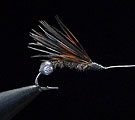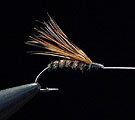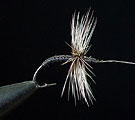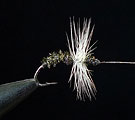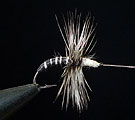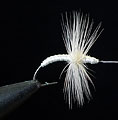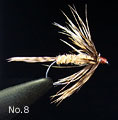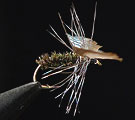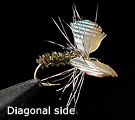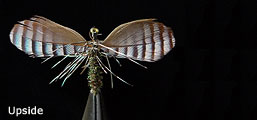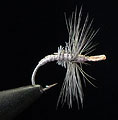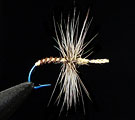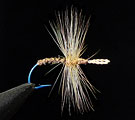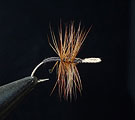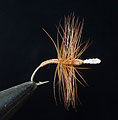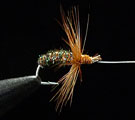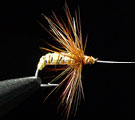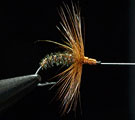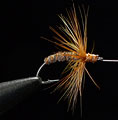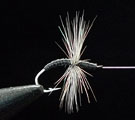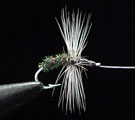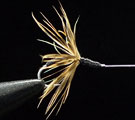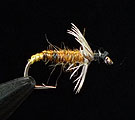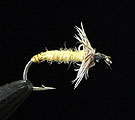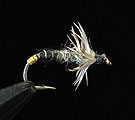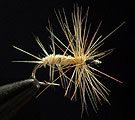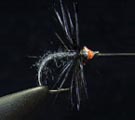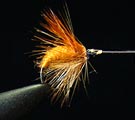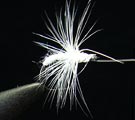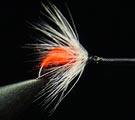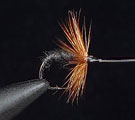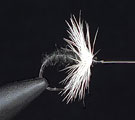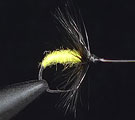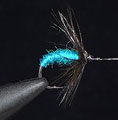Traditional Japanese Fly Tenkara 3 |
 |
| There are flies I got at various places or tied by myself. It is interesting that tenkara fly has local color. |
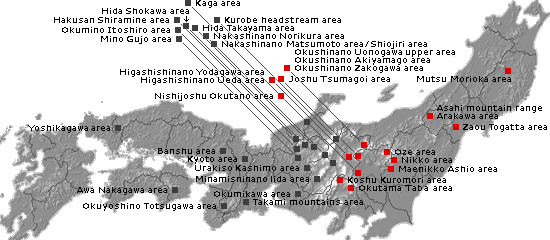 |
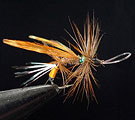 |
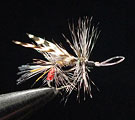 |
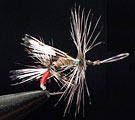 |
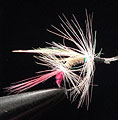 |
||||
Mutsu Morioka area
These are modern Morioka Kebari for Tenkara fishing that were tied by the traditional technique of Mr. Hiroshi Ishizawa.
These are different in shape from conventional style Morioka Kebari, and are characterized by having wings.
The hook is used Masu type of No. 6 - 7, and the eye of the monofilament line is attached.
Mr. Hiroshi Ishizawa is a successor of Morioka Rod that is one of the two major traditional rod in Tohoku region called "Shonai (Yamagata) Rod of the Sea, Morioka Rod of the River",
and is also the successor of the traditional Morioka Kebari.
He makes an effort for the succession of the traditional technique, but seems to be also positive in adding new ideas and improvements to the tradition. |
|||||||
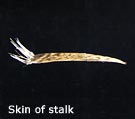 |
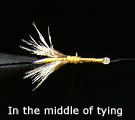 |
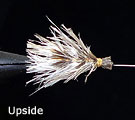 |
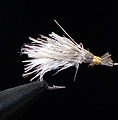 |
||||
Zaou Togatta area
This is "Togatta fly" that Hunter of the south Zaou hot spring village has handed down.
The skin of the stalk when pheasant and copper pheasant's rectrixes are picked off is used as wing,
and it is tied to the hook for sea perch fishing with a golden yellow silk thread trebl places.
It seems to look like the fishing of fluttering caddis of flyfishing.
This is unparalleled fly invented by the environment of the Sumikawa River where a lot of caddisflies (Stenopsyche japonica) live, and fisherman's wisdoms.
It is said that the person who is able to make this fly became very few, too now.
The fly of image was tied by myself referring to a detailed introduction of web page "Fu-un western style flyfisher notebook".References: Fu-un Seiyo Kebari Tsurishi-cho [Fu-un western style flyfisher notebook]. Retrieved September 27, 2006. Yoshio's road that came at one time. Miyagi Television Broadcasting, Retrieved September 27, 2006. |
|||||||
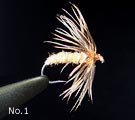 |
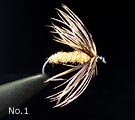 |
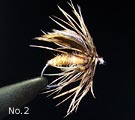 |
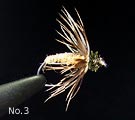 |
|||||
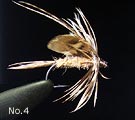 |
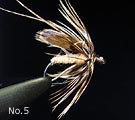 |
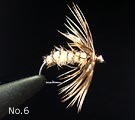 |
|
|||||
Nikko area
Nikko flies (Gorocho flies) were modeled after Gorocho (Stenopsyche japonica) because many Gorocho lived in the Yugawa River of Nikko.
These were ordered to Hardy by someone of diplomats or Tokyo Angling club's members
that they had enjoyed trout fishing in the Yugawa River and Marunuma lake in the beginning of Showa era or the late Meiji era.
These flies were registered to Hardy and records remain even now.
These have hackle of Japanese hen pheasant's breast feather, body of cotton of flowering fern.
In the book "Trout fishing" of Hiroki Meguro, Nikko flies are shown from No.1 to No.8,
but the details cannot be understood because illustrations are indistinct.
Especially, Nikko No.7 looks like a type with wings, but the difference between No.2 and No.7 is unclear.When I was reading the old fishing magazine "Angling No.15" that I was keeping, I found being written as "Gorocho seems to be Gomafutobikera (Semblis melaleuca)" in "The search of Gorocho from documents" by Mr. Kazuya Tada. When I looked over the document that he was referred to, surely "Suicide of Rainbow trout" by Mr. Reika Sawa of "Yamakai no Tsuri (Fishing in the valley)" had a word of a "Gomafutobikera". Although I was believing until now that Gorocho is Higenagakawatobikera (Stenopsyche japonica), Since a name called Gomafutobikera came out, I have thought that Gorocho may be not the name which shows a specific kind and it may be a general term for the large-sized caddis fly which looks whitish when it flies. References: Meguro, H. (1979). Masu-tsuri [Trout fishing]. Reprinted edition, Tokyo: Ateneshobo. Tada K. (1986). Bunken karano Gorocho Tansaku [Search for Gorocho from Documents]. Angling. 15, Tokyo: Kosaido Publishing. Saionji, K. (1974). Tsuri Rokujunen [Fishing 60 years]. Tokyo: Futami Shobo Publishing. Sawa, R. (1941). Niji-masu no Jisatsu [Suicide of Rainbow trout]. Yamakahi no Tsuri [Fishing in the valley]. Tokyo: Shunyodo Publishing. Fishing: Nyumon Nihon no Fly fishing [Japanese Fly fishing Guide]. 22, (Extra issue 1981), Tokyo: Sanpou Publishing. |
||||||||
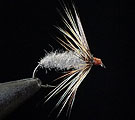 |
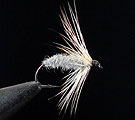 |
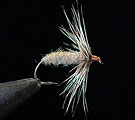 |
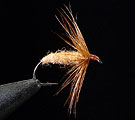 |
|||
Nikko area
Besides Gorocho flies, there are Nikko flies that were tied by Japanese bantam hackle (There is also document written to be Gamecock hackle.) and water shrew fur.
They are called "Kingoma" and "Gingoma".
Japanese bantam was specified for the natural monument in 1941.
And the persons who captures water shrew (It is specified for the Ministry of the Environment red list in Kyushu region.) has decreased.
All became hard-to-find materials now.
Left 2 flies are tied by water shrew fur and by substitut -ing golden badger hackle or silver badger hackle.
The third fly from the left is tied by water shrew fur that mixed cotton of flowering fern and by substituting grizzly hackle.
Flies that were tied by the water shrew fur are attractive for the fishers to say nothing of the trout because the bubble taken between a beautiful, smooth furs reflects the light and they seem to shine to the silver color in the water.
In the book "Trout fishing" of Hiroki Meguro, there is a line with "Besides Gorocho flies, Beat with Chong-Chong the water surface with fly that was tied by hackle of red-center, black-tip."
Right fly is reproduction of it.References: Meguro, H. (1979). Masu-tsuri [Trout fishing]. Reprinted edition, Tokyo: Ateneshobo. Saionji, K. (1974). Tsuri Rokujunen [Fishing 60 years]. Tokyo: Futami Shobo Publishing. Nikko Masu-tsuri Kenkyusho [Nikko Trout Fishing Laboratory]. Retrieved July 22, 2010. |
||||||
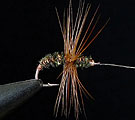 |
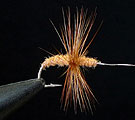 |
 |
 |
||||
Maenikko Ashio area
We recall the matter of the poisoning of copper from the word "Ashio".
When limiting it to Ashio, the Watarasegawa River in the base of Bizentateyama and the Koshingawa River at downstream of Ginzandaira were influenced by it.
The Matsukigawa River of the headstream went to ruin because of the collapse of Mae-Nikko mountain range that depends on the smoke pollution and the conflagration.
Because plowing a field was the main agriculture in the mountainous area of steep slope, neither the cow nor the horse were needed for it.
So fly fishing that do not use furled tapered line was devised by Mr. Kashiichi Yagisawa of Ashio Kakemizu.
Copper wire was used from backing to finish to put weight to the fly because furled tapered line was not used.
The hook was Sodegata No.11. The hackle was Nagoya cochin. The body was tied by cotton of flowering fern or peacock herl.
The rod length was 3m.
The line was 4.2m in total length, the nylon line No.2 (2X).
These are flies that I reproduced.References: Suzuno, F. (1993). Yamaryou [Mountain fishing]. Tokyo: Rural Culture Association. |
|||||||
 |
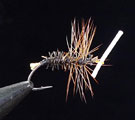 |
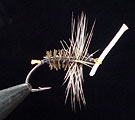 |
 |
|||||
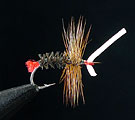 |
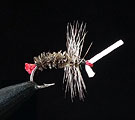 |
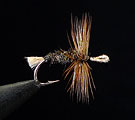 |
|
|||||
Okushinano Akiyamago area
These are traditional flies of Akiyamago village that is located on the border of Nagano and Niigata prefecture.
These are very simple flies because those are made of two silk thread of yellow and black, the bantam hackle, the hook of kitsune No.8-10,
and these do not use even head cement.
The eye is made by two yellow silk thread that was twisted, and to keep the eye hole a paper string is inserted.
The body is made by cutting the hackle.
The upper row are flies of Mr. Shigeo Yamada, and he was a expert of kebari fishing and the last commercial fisherman of Akiyamago.
The bodies are all black, the hackles are three kinds, black, whitish color and brown with black stem.
They were chosen by the situation of streams.
The rod length was 3m.
Rig is made from 2m of furled tapered line of horse tail, 1m of No.2 (2X) nylon line and 1.5m of No.1 (4X) nylon line.
The furled tapered line of horse tail is short so that the fly may not be pulled to this side by the weight of line.
Shorter furled line of horse tail is almost the same as Mr. Takamori's rig of the Zakogawa River.
The left 2 of lower row are flies of Mr. Kenzo Hayashi who is continuing adhering to fishing by Akiyamago fly.
The right 2 of lower row are flies that were arranged by the landlord (Mr. Shigeo Yamada's son) of a guesthouse "Yuzansou" and the former storekeeper of fishing tackle shop.
These are introduced on the web page "Fu-un western style flyfisher notebook".
As for all the hooks of lower row, Maru-seigo No.7-9 are used.
These are all flies that I replicated.References: Uesugi, D. (2001). Hayashi Kenzo no Akiyama Kebari. Tenkara club. 2, Tokyo: Kosaido Publishing. Akiyamago no Shigeo ga kataru kebari no hanashi [Story of kebari which Shigeo of Akiyamago tells]. Fishing. (September 1978), Tokyo: Sanpou Publishing. Fu-un Seiyo Kebari Tsurishi-cho [Fu-un western style flyfisher notebook]. Retrieved September 27, 2008. |
||||||||
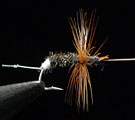 |
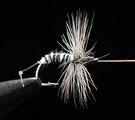 |
 |
 |
||||
Okutama Taba area
Okutama area is called the inner garden or inner parlor of Tokyo, and has many visitor, and has produced many commercial fishermen and experts.
It is said that kebari-fishing has been called "Hane-tsuri" in Taba from the old days.
The left is fly of Mr. Tadashi Morioka who inherited the tradition.
The hook was sodegata hineri No.8,
the body was tied by peacock herl,
the hackle was bantam or rooster,
and the fiber of wild silkworm cocoon was tied to the end of body.
The peculiar tradition of Tanba is retractable tippet.
It pulls two knots on the end of body, and can renew the tippet that got damaged.
From the left the second is fly of Mr. Iwao Sakai who got to know the fly of Tanba, and adopted it and used at the Kosugegawa River.
These are flies I replicated.References: Tokado, H. (2013). Shokuryoshiden [Lives of Commercial Fishermen]. Tokyo: Rural Culture Association. |
|||||||
My Best Streams |
Fukushima | Hinoematagawa Hinoemata | Tochigi | Ojikagawa Miyori | Yugawa Akanumachaya | Yamanashi | Yanagisawagawa Ochiai | Shiokawa Kuromori, Masutomi | Nagano | Daimongawa Iridaimon | Gifu | Shokawa Hirase | Oshirakawa Hirase | Isshikigawa Isshiki | A upper branch of Shokawa | | Mazegawa Kawaue | Itoshirogawa Itoshiro | Togegawa Itoshiro | Shirakawa Kashimo | Shiga | Adogawa Katsuragawa | Harihatagawa Furuya | Adogawa Kutsuki | Kitagawa Udotani | | Kitagawa Noge | A branch of Kitagawa | Asogawa Kijiyama | Amasugawa Amasugawa | | Echigawa Yuzurio | A branch of Echigawa | Shibukawa Kozuhata | Shibukawa Wanami | | Chayagawa Yakeno | Kyoto | Tananogawa Yamamori | Yuragawa Ashiu | Naesugidani Ashiu | Sasarigawa Sasari | | Katsuragawa Hirogawara | Kutagawa Kuta | Besshogawa Hanase | Nakatsugawa Kumogahata | Wyoming USA | Gibbon River and Madison River | Firehole River | Soda Lake | Colorado USA | Boulder Creek | South Boulder Creek (Upstream) | South Boulder Creek (Downstream) | Big Thompson River | Rocky Mountain National Park | South Island New Zealand | Lake Wakatipu | Mataura River | Ontario Canada | Credit River Erindale Park | |
Flies |
Equipment |
| Back to Main Home Page | Profile | Links |
Home |
Paper Craft of Japanese Trout and the World Trout © 1997 Yoshikazu Fujioka |
